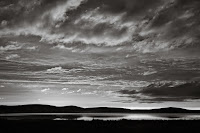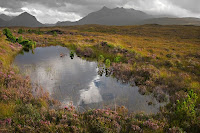Although I have never met Loori, a few years ago I stumbled across an extraordinary book of his called The Zen of Creativity, and have been admiring - and following - his work ever since. This book (which I've had to purchase a second copy of because my first copy is riddled with creased page corners bookmarking its veritable storehouse of distilled wisdom) turned out to be but one of many, many spiritually rich books he has authored - on Zen, photography, and the creative life in general - and illustrated with his own deeply soulful images. It should come as no surprise that Loori's spiritual / photographic journey started sometime in the early 70s when he attended a workshop conducted by Minor White, who was himself - arguably - the finest "spiritual leader" of photography of his era. Loori not only continued on with his own masterful photography, but eventually became one of the West's leading Zen masters. He was also the founder and spiritual leader of the Mountains and Rivers Order and abbot of Zen Mountain Monastery in New York's Catskill mountains.
Another book of Loori's that I own and treasure, and which perfectly illustrates his basic philosophy of nonseperability between art and spiritual practice, is Hearing with the Eye. This book - ostensibly a collection of images that Loori captured around Point Lobos, California (fused with a quiet but illuminating prose) - is a gentle, graceful meditation on the illusory boundaries between inner and outer realities. Much the same, and more, can be found in another, and even more recent, of Loori's books, called Making Love with Light.
A detailed account of his life and philosophy (including links to YouTube videos and a portfolio of his photography) can be found on the Mountains and Rivers Order site by following this link.
There are a total 24 books in all listed on Amazon's Loori page. The aspiring Zen student wondering about what creativity has to say about life, and/or the aspiring (or seasoned) photographer wondering about what Zen practice has to say about taking pictures - and even the stray physicist or two who may secretly wonder about whether there is more to the universe than what equations alone reveal - can have no better companion to start exploring these "wonderings" with than Loori, via his writings and photographs.
Though I may never have been graced by Loori's physical presence as a "teacher," I - and therefore my own work and vision - have nonetheless been deeply touched by the lessons and wisdom of this graceful soul. And, although there obviously remain plenty of souls left on this planet who can communicate to the rest of us beautiful and delicate eternal truths with their cameras (and "gifted seers" are - luckily for the world - born every day), this one preternaturally enlightened "eye" is - mournfully - no more (but only so far as corporeal existence goes).
"To know objects only through dissecting and cataloguing them is to miss their full reality. It is to fall asleep amidst the mystery and to become numb to the wonder of this great Earth." - John Daido Loori

























